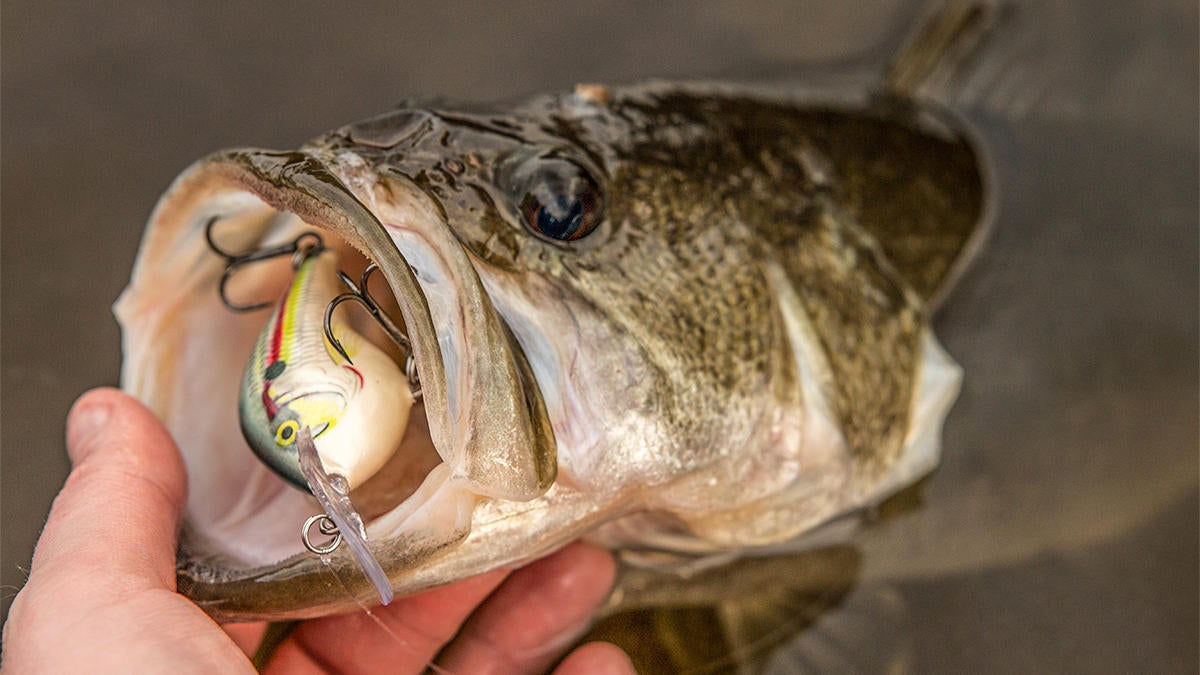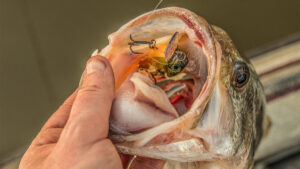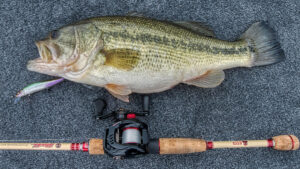How your bass is hooked can tell you a lot about the current feeding behavior and preferences during a particular day of fishing. Sure, it’s tempting to unhook your catch quickly and keep casting, but before you get those hooks out, take a few seconds to make note of a few things.
Here’s what I have noticed over the years.
If it’s choked, you’re in business
This is the most obvious scenario, so we’ll start here to get it out of the way. If you’re fishing a lure and the bass continuously suck it down towards the back of their throats, it’s a safe bet you’re doing the right thing. Major adjustments aren’t often necessary in this situation.
If you drill down a bit further, this can also help you determine the most productive areas on a particular fishery. When you’re only getting a few bites, but the fish are choking your lure, that might be a sign that you’re missing part of the puzzle. Your bait selection is spot-on, but perhaps it’s time to start seeking out other areas. It can be as simple as switching from primary points to secondary points or even a slight change in casting angles can be a huge difference maker.
Takeaway: If the bass are choking your lure, consider yourself lucky. You’ve got one part of the equation figured out for sure. If the bites are few and far between, don’t be afraid to branch out to different areas.
Underneath the jaw often calls for an adjustment
Especially when you’re fishing crankbaits or jerkbaits, you’ll sometimes notice your fish being hooked in the bottom of their jaw. Not in the mouth, but underneath their chin. This isn’t a huge deal for your landing percentage, as that’s usually a high-percentage area for hooks to grab, but it’s a sign you could be missing out on an even hotter bite.
In my experience, this situation often means that I’m fishing a bit too deep in a particular area. I believe that bass prefer to feed upwards-attacking baits from underneath-so I try to keep my moving baits a bit higher in the water column than where I believe the bass are sitting. You can certainly catch fish running your jerkbaits or crankbaits underneath them, but you’ll catch a lot more with a slight depth adjustment.
Takeaway: As an example, if you’re fishing a 10-foot diving crankbait over a point and you’re seeing bass hooked underneath the jaw, try switching to a 6-foot diving crankbait. At times, the difference can be remarkable.
Outside the mouth may mean it’s time to be stubborn
I’m a big believer on this one, so hear me out. Nothing is more nerve wracking than to hook a big bass on the outside of the mouth; especially when you’re using treble hooks. This gives bass a lot more opportunity-and leverage-to twist the hooks during the fight and come unbuttoned. But it can also be a major clue.
When bass are hooked outside the mouth, it often means they swiped at your lure out of reaction or pure predatory instinct. It might not have been actively feeding. This can be your clue that repeated casts will produce more action on that particular day. When bass are lethargic, I’ve had outstanding success making up to a dozen casts to each good-looking piece of cover. There very well could be a big bass there, but you’re eventually going to have to tick it off and make it swat at your lure.
Takeaway: As a kid, did you ever have someone put their finger right in front of your face and keep repeating “I’m not touching you”? It’s irritating as heck and after a few times, you probably got mad and swatted your buddy’s finger away. Repeated casts can do the exact same thing to lethargic, neutral-state bass.
Back hook means you’re almost there
This is another situation that can result in lost fish throughout the day. When you’re using treble-hooked moving baits, it’s not ideal to hook your fish on the back hook. This means it’s time for an adjustment. You’ve obviously figured out what lure they want, but something still isn’t quite right.
This is where experimentation needs to come in. I know it’s tough to change baits when you’re getting bit, but it often leads to greater things. Avoid stubbornness and try several different things. There’s no cut-and-dry solution here. It could be a slight color change, switching to a rattling or non-rattling model or even adding a dot with a marker that gives the bass something to target. Heck, some people are big believers in changing your front treble hook to a red-colored hook.
Takeaway: My first change is normally color. Then I’ll switch to a different sound. Or sometimes switching from a 1.5 to a 2.5-sized squarebill (or vice versa) can make all the difference. Try not to be robotic or resistant to change. Small things make a big difference when you’re hooking ’em on the back treble.
















